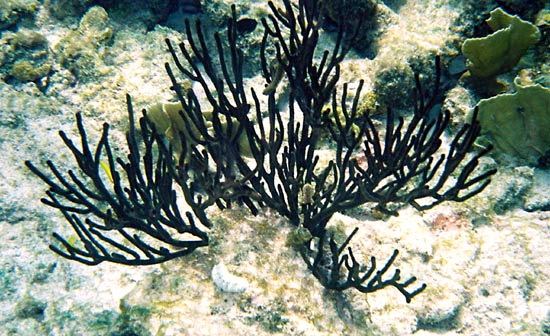Kingdom Animalia Higher classification Hexacorallia Rank Order | Scientific name Antipatharia Phylum Cnidaria Subclass Hexacorallia | |
 | ||
Similar Sea pen, Antipathes, Alcyonacea, Anthozoa, Precious coral | ||
Black coral
Black corals (Antipatharia) are a group of deep water, tree-like corals.
Contents
Black coral 1968
Description and characteristics
They normally occur in the tropics. They are also found in rather dark water areas such as New Zealand's Milford Sound where they can be viewed from an underwater observatory or via SCUBA diving. There are about 280 known species of Antipatharians in 42 genera.

Though black coral's living tissue is brilliantly colored, it takes its name from the distinctive black or dark brown color of its skeleton. Also unique to black coral are the tiny spines that cover the surface of the skeleton, the origin of the nickname little thorn coral. In the Hawaiian language, black coral is called ‘ēkaha kū moana and is the official state gem of Hawaii. Black coral is listed in Appendix II of the Convention on International Trade in Endangered Species (CITES).
Lifespan
In March 2009, scientists released the results of their research on deep-sea (depths of ~300 to 3,000 m) corals throughout the world. They discovered specimens of Leiopathes to be among the oldest continuously living organisms on the planet: around 4,265 years old. They show that the "radial growth rates are as low as 4 to 35 micrometers per year and that individual colony longevities are on the order of thousands of years".
Ecology

Whip coral (Cirrhipathes species) host as many as six other species. Whip coral gobies and barnacles permanently inhabit the skeleton. The goby and shrimp quickly hide on the opposite side skeleton's when a threat approaches. The goby and damselfish lay their eggs on the skeleton. The damselfish bites off the polyps to expose the nesting site.
Families
List of families according to the World Register of Marine Species :
